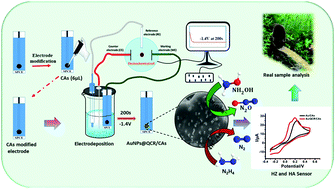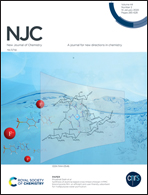Electrosynthesis of carbon aerogel-modified AuNPs@quercetin via an environmentally benign method for hydrazine (HZ) and hydroxylamine (HA) detection
Abstract
An ultrasensitive electrochemical sensor fabricated using an environmentally benign hydrothermal method for the detection of environmental pollutions, namely, hydrazine (HZ) and hydroxylamine (HA) has been described. A large amount of HZ and HA are being used in public and private sectors in different fields, which can cause environmental, biological and physiological changes. The detection and control of HZ and HA are important for environmental safety and protection. We have developed highly sensitive Au@QCR–CA-modified SPC electrodes, using which well-separated oxidation peaks and enhanced peak currents of HZ and HA were observed owing to the superior conductivity of CAs and the excellent catalytic activity of Au@QCR nanoparticles. The various kinetic and experimental parameters were also optimized. The fabricated sensors were also applied for the detection of HZ and HA in real sample analysis. This study offers the best platform to explore carbon aerogel-modified AuNPs@quercetin via an environmentally benign method for the detection of HZ and HA using a highly sensitive and selective electrochemical sensor.



 Please wait while we load your content...
Please wait while we load your content...